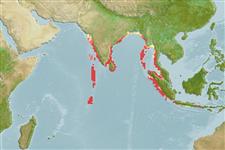Common names from other countries
Teleostei (teleosts) >
Acanthuriformes (Surgeonfishes) >
Acanthuridae (Surgeonfishes, tangs, unicornfishes) > Acanthurinae
Etymology: Acanthurus: Greek, akantha = thorn + Greek, oura = tail (Ref. 45335).
More on author: Randall.
Environment: milieu / climate zone / depth range / distribution range
Ecology
Marine; reef-associated; depth range 2 - 30 m (Ref. 90102). Tropical; 24°N - 9°S, 71°E - 116°E
Indian Ocean: Bay of Bengal (Ref. 8940) and the Andaman Sea west to Maldives and Chagos Archipelago, and east to islands of southern Indonesia at least to Bali.
Size / Weight / Age
Maturity: Lm ? range ? - ? cm
Max length : 25.0 cm TL male/unsexed; (Ref. 9710)
Dorsal spines (total): 8; Dorsal soft rays (total): 23 - 33; Anal spines: 3; Anal soft rays: 22 - 29. Margin of caudal fin narrow and white. No orange area behind gill opening and extending ventrally behind base of pectoral fins (juveniles mimic the angelfish Centropyge eibli) (Ref 9808).
Occurs in shallow lagoon and seaward reefs, in areas of mixed coral, rock or sand. Juveniles mimic the cryptic Centropyge eibli (Ref. 9710, 48637).
Life cycle and mating behavior
Maturities | Reproduction | Spawnings | Egg(s) | Fecundities | Larvae
Randall, J.E., 1993. Acanthurus tristis, a valid Indian ocean surgeonfish (Perciformes: Acanthuridae). Spec. Publ. J.L.B. Smith Inst. Ichth. (54):1-8. (Ref. 8940)
IUCN Red List Status (Ref. 130435)
CITES (Ref. 128078)
Not Evaluated
Threat to humans
Harmless
Human uses
Fisheries: commercial; aquarium: commercial
Tools
Special reports
Download XML
Internet sources
Estimates based on models
Preferred temperature (Ref.
115969): 28 - 29, mean 28.7 (based on 180 cells).
Phylogenetic diversity index (Ref.
82804): PD
50 = 0.5000 [Uniqueness, from 0.5 = low to 2.0 = high].
Bayesian length-weight: a=0.02344 (0.01103 - 0.04981), b=2.96 (2.79 - 3.13), in cm Total Length, based on LWR estimates for this Genus-body shape (Ref.
93245).
Trophic level (Ref.
69278): 2.2 ±0.1 se; based on size and trophs of closest relatives
Resilience (Ref.
120179): High, minimum population doubling time less than 15 months (Preliminary K or Fecundity.).
Fishing Vulnerability (Ref.
59153): Low vulnerability (15 of 100).
